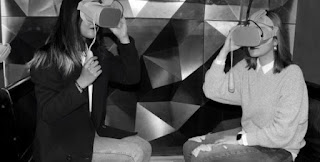Back in April 2019, Monash University awarded posthumous
degrees to four students, as well as a certificate of recognition to one
student of the Melbourne College of Pharmacy, whose education was cut short by
World War I. Inspired by this, Monash students have developed Return; the way
back home, now open at the university’s Clayton campus, running through until
June next year.
 From a design point of view, the students developed the
whole visual identity in consultation with content experts in the Library, a
true testament to their passion, commitment and talent.
From a design point of view, the students developed the
whole visual identity in consultation with content experts in the Library, a
true testament to their passion, commitment and talent.
The exhibition explores the different ways trauma impacted
soldiers and their families when they returned home after World War I, all told
via interactive technologies designed by Monash University Master of Design
students. And it’s impressive.
Featuring unique items held by Monash University Library,
the University Archives and the Faculty of Pharmacy and Pharmaceutical
Sciences, the exhibition particularly honours the legacy of Sir John Monash,
who was commissioned 8 days after the armistice was signed to oversee the
repatriation of the surviving Australian soldiers and their dependents.
For the soldiers who were returned under this scheme,
repatriation was just the beginning. In particular, those who survived the
conflict needed extensive rehabilitation to adjust to the loss of those who
didn’t return. While some veterans went on to lead successful lives and
careers, many struggled to reintegrate in the face of the physical and mental
trauma they experienced.
160,000 young men and women survived the war, and this powerful
new exhibition shines a light on the massive transformative leadership of Sir
John Monash, completing the repatriation in just 18 months.
Working with Library staff, eight Master of Design students
specialising in multimedia and interaction designed and built the interactive
digital elements of the exhibition as part of their final-year project.
Within the exhibition, there are three major studies of trauma,
both physical and mental, that impacted on the journey home of soldiers and their families.
Using virtual reality, visitors ride a tram back to 1920s Melbourne and visit some of the exhibition sites. Employing projection mapping, a newspaper of the time responds as the pages are turned revealing the day’s news from the era, and other interactive installations uncover the issues surrounding repatriation through digital interfaces.
Using virtual reality, visitors ride a tram back to 1920s Melbourne and visit some of the exhibition sites. Employing projection mapping, a newspaper of the time responds as the pages are turned revealing the day’s news from the era, and other interactive installations uncover the issues surrounding repatriation through digital interfaces.
 From a design point of view, the students developed the
whole visual identity in consultation with content experts in the Library, a
true testament to their passion, commitment and talent.
From a design point of view, the students developed the
whole visual identity in consultation with content experts in the Library, a
true testament to their passion, commitment and talent.
The exhibition curator, Dr Anne Holloway, said framing the
exhibition around those who worked in allied health honours Sir John’s
connection to the Faculty of Pharmacy and Pharmaceutical Sciences, and the
original project commemorating the lives of the students who never returned from The Great War, while highlighting
the riches of the University’s special collections.
This video documents the sentiment and process of staging
the exhibition:
WHERE: The Gallery, Sir Louis Matheson Library – Monash University
Clayton campus
UNTIL: 22 June, 2020
COST: Free


Comments
Post a Comment